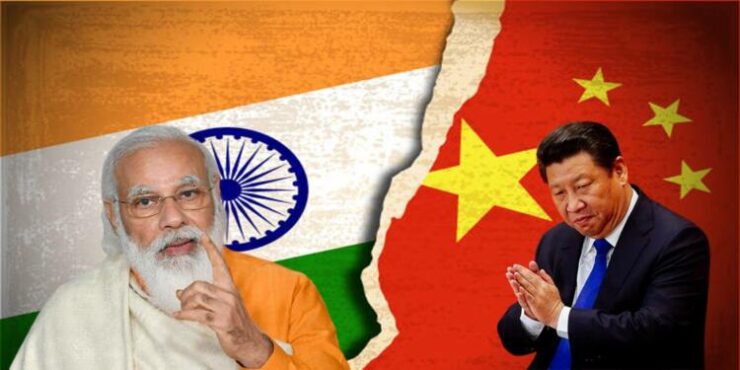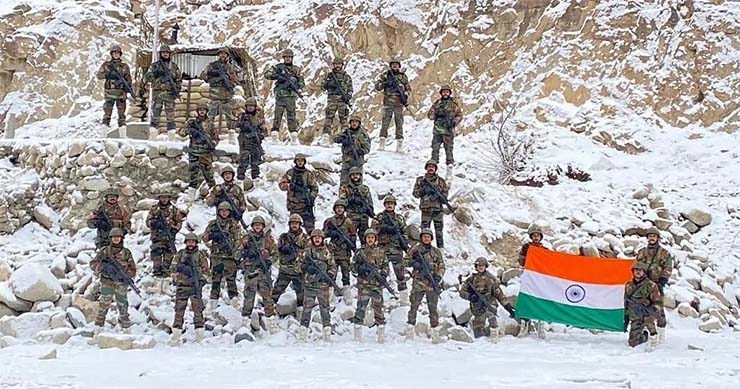
In May 2020, amid the thick of the coronavirus-induced pandemic, when the world was still trying to understand the intricacies of the pandemic and plan a strategy to tackle it, the Indian Army (IA) was jolted out of its fight against the coronavirus and it plunged deep into an actual fight with China’s People’s Liberation Army (PLA). The scene of action was in Ladakh – in the Aksai Chin area.
A quick recap of what happened then in 2020 is in order but includes a bit of history too. Indians, as is oft-repeated, have a feeble sense of history; nevertheless, this mindset has changed and the pages of history have flipped fast-forward to more recent times, when the Indian Army has either snubbed the PLA, or given it a bloody nose, whether it was in the Eastern Sector in Doklam, or in Ladakh. The ghost of 1962 appears to have been exorcised, both in the Indian Army and the bureaucracy; the defeatist mindset has been left behind and India no longer, after being slapped on one cheek, offers the other cheek; it rather, slaps back, and hard – much to the surprise of its adversaries.
The Indian Army had to postpone its annual summer exercise in mid-March 2020, along the Line of Actual Control (LAC) due to some soldiers testing positive for the coronavirus. The exercise involved the movement of troops from Himachal and has, normally, been a mirror to a PLA exercise, which, for whatever reasons, was also postponed by a month. The Indian Army was caught off-guard by the PLA manoeuvres in April when its troops quickly deployed in the Galwan Valley and the ‘fingers’ on the northern bank of Pangong Tso. Disregarding all pandemic protocol, Indian troops were mobilised to match the PLA deployments. The first confrontation in the region reportedly occurred on May 5-6, 2020, when a major scuffle resulted in injuries, some serious, to soldiers on both sides. It was, however, on June 15, 2020, that a very serious ‘scuffle’ took place at Galwan, resulting in 20 Indian Army causalities, and an even higher number in the PLA (although China persists in its official figures in single digits; foreign intelligence and foreign media reports have carried figures ranging from 25 to 45).
Galwan, a major irritant in bilateral ties
Galwan is now major punctuation in the troubled bilateral relationship, which had, somewhat stabilised, with a modicum of trust, after the one-on-one meetings between the two leaders. While India has interpreted Galwan as a case of Chinese treachery and places the onus on China to restore the status quo, their viewpoint is entirely different. China, it seems, was rattled by the Indian road between Daulat Beg Oldi (DBO) and Karakoram pass; the PLA action against India, hence, has been projected as a case of guarding the border and defending the motherland. A Chinese flag ‘once raised on Pangong Tso’ was taken by PLA troops from units posted along the LAC to educational institutions to stoke pride in the military and invoke muscular nationalism, wherein the military reiterates its allegiance to the Chinese Communist Party (CCP), as represented by President Xi Jinping.
Fifteen rounds of talks between India and China at the commander level, with the levels being raised at times, to find an end to the confrontation have yielded no results. An early resolution to the lingering 25-month standoff appears unlikely, apart from the partial disengagement at the hotspots. Despite the pullout of forces from the Galwan Valley, Pangong Tso, and Gogra-Hot Springs areas, both countries still have over 60,000 troops with armoured, rocket, artillery, and missile support in the Ladakh theatre. The potential of a local clash persists because the Chinese have not displayed any inclination to proceed with the disengagement and de-escalation process. Rather, in recent months, the PLA has built two bridges across the Pangong Tso, within the area that it occupies; the bridge, constructed most recently has the capability to allow heavy vehicles and tanks to move across it between the north and south banks. US Army’s Pacific Commanding General Charles A Flynn said in his visit in early June, “Some of the defence infrastructure constructed by China near its border with India in Ladakh is alarming…and eye-opening.”
India’s fresh apprehensions
The Indian Army has not lowered its vigil as intelligence reports indicated that the PLA may take advantage of the Ukraine conflict to transgress into fresh areas on the LAC. The Indian Army is, expectedly, under strict instructions from the government that any PLA transgressions are to be matched and replied to without ceding an inch of territory.
So much for the narrative on the current status on the military front. Nevertheless, questions that were raised in 2020 have not yet been answered. What could be the strategy behind China’s actions, as China does not move without thinking of the pros and cons of its actions. Bertil Lintner mentioned in his book ‘China’s India War’ that the 1962 war was a diversionary tactic against the failure of Mao’s ‘Great Leap Forward’. In 2020 (and even today), were the stars not favourably aligned for Xi Jinping to try a diversion? The only insight into who Xi Jinping is, what motivates him, and what are his constraints, can probably help find the answers.

China’s (read Xi Jinping) ambition to place itself as the future superpower, standing abreast if not ahead of the USA, took a massive hit with almost all nations, and its own people, dissatisfied with its handling of the pandemic. The pandemic has disrupted the global supply chains, affecting not just China’s economy but the global economy at large. Although not publicly acknowledged, Xi Jinping is facing internal unrest, which can transform into a challenge to his aspiration for a third term in power. Whether the misadventure in Ladakh was driven by these issues – domestic challenges amid a never-ending pandemic and the effect on the economy – or was a case of opportunism or a mix of both, is difficult to gauge due to the strict media control and propaganda within the country.
It, however, does seem to be an interplay of insecurity and confidence (or overconfidence) that led China to do what it did. PLA’s move to forcefully alter the situation along the LAC was in all probability, therefore, a move to divert the attention of the global audience from arising uncertain conditions, and the domestic problems such as unemployment, low growth, thin fiscal stimulus, and also the pandemic-induced lockdowns.
Impact of Chinese behaviour
These two years – from 2020 until now – have, however, imposed heavy burdens on both nations. The tensions in Ladakh, and other parts of the LAC in the central and eastern parts of India, have influenced all aspects of India-China relations. Bilateral trade, it may be argued, still continues, however, strategic and security concerns are now being underscored in India’s economic and technology policies; an active engagement in QUAD, participation in the Indo-Pacific Economic Framework (IPEF), and hosting the foreign ministers of ASEAN, are the recent examples.
On the other hand, as per comments in the media, China seems to be getting anxious about being restricted in its activities in all spheres. China views the accelerated engagement of the QUAD and the IPEF as means to contain its activities, without an inward look at its own policies in the area that are considered aggressive across the region, and are causing apprehensions. This was evident by South Korea’s evincing interest in the QUAD, and the statement by Japan’s PM, Fumio Kishida, at the just concluded Shangri-La Dialogue in Singapore; at the same event, the Australian Defence Minister asked China to follow the rules-based order, rather than attempting to bully by a show of force.
Hostile actions against UN missions
China, however, continues to have a ‘couldn’t care less’ attitude. Its fighter aircraft aggressively ‘buzz’ reconnaissance aircraft of other nations on UN missions and flying in international airspace, which China claims as its own. A Canadian aircraft on a UN mission to monitor sanctions against North Korea was buzzed by Chinese aircraft; an Australian aircraft on a routine surveillance mission in the South China Sea (SCS), had a Chinese aircraft dispense metallic chaff in close proximity, causing damage to it; there have also been reports of a Chinese ship using laser against an Australian aircraft cockpit, endangering the crew. China calls these actions self-defence against provocations!
The hostile intent of China to expand its footprint into the Indo-Pacific to counter the US and its allies is also visible in the recently-concluded security pact with the Solomon Islands. The details are shrouded in opacity, but the explanation given by both parties is that the agreement is to deal with the islands’ internal security situation. The USA, New Zealand, Australia, and other Pacific nations, are naturally apprehensive since the agreement has the potential of China placing its military in the islands in the future. Another question that comes to mind: is China wanting to militarily prop up friendly regimes, as it had done in the past elsewhere? If true, the case may have sweeping geo-strategic consequences.
Apart from the Indo-Pacific, China also has its hands full with Taiwan and Russia. China has, at regular intervals been indulging in a show of force against Taiwan, a country that it claims as its own, albeit as a break-away province, and hence, to be integrated, sooner or later, with the mainland, and if necessary, by use of force. China declared itself a ‘long-lasting friend’ of Russia, during a meeting of the two leaders during the winter Olympics in February and is now an active participant in the Russian disinformation campaign amid the Ukraine war.
Tackling the arm-twisting policy
Coming back to India-China relations. From China’s perspective, destabilising the LAC, and creating new flash-points – but averting a full-scale conflict – seemed to have been the most cost-effective way to twist India’s arm and get it to understand China’s interests. The cost of the disturbed relations, adverse global/regional reaction, and the effect on China’s overall South Asia and the Indian Ocean strategy, were probably considered worrying, but controllable. For India, it is imperative to not lower its guard and fall prey to China’s outdated propaganda of an indifferent outlook towards India, dismissing India’s capabilities and role in the region. India has realised and must continue to work towards the realisation, that it has a major role to play in forming China’s foreign policy and its future investment policies in the BRI/Western Development Strategy/Two Oceans Strategy. To mould China’s behaviour towards itself, India has to stop viewing itself through the adverse power differential between the two nations. Rather, India should make China realise that its behaviour towards India and other nations is feckless and counter-productive, obscuring the strategic value of India to China. India should, thus, extract benefits for itself, towards concessions and reconciliation. For India, however, this appears a difficult proposition, since China (Xi Jinping) continues to display insecurity through a façade of confidence.
The stability in the relationship, hence, is improbable!
–The writer is an IAF veteran. The views expressed are personal and do not necessarily reflect the views of Raksha Anirveda








